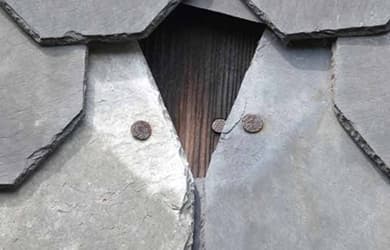If you’re currently struggling with roof leaks or are just looking to learn more, this guide can help. Whether you’re wondering about what causes roof leaks, how to find a roof leak, or how to fix a roof leak, we’ve got you covered.
Whether your roof is freshly installed or on its last legs, roof leaks are an inevitability. Use this guide to find out what causes a leaky roof, and learn what you can do to fix the leak when it happens. Don’t ever put off fixing leaks—leaks that aren’t properly addressed can lead to severe water damage that costs thousands.
CAUSES OF ROOF LEAKS
Before we dive into how to patch a leak, let’s review roofing problems that commonly lead to roof leaks. These problems are worth looking into even if you don’t have a leaky roof right now, as they frequently lead to them.
GENERAL WEAR & TEAR
Nothing lasts forever. Gradual wear and tear and age could be what’s causing your roof’s leaks. Things that accelerate the age of your roof include:
- Extreme temperature swings
- Severe weather
- Prolonged sun exposure
- High humidity levels
- Elevation (higher UV exposure)
- Poor installation practices
Unfortunately, these are mostly environmental factors out of your control. One way or another, these factors are huge in determining the lifespan of your roof.
FLASHING DAMAGE
Flashing is a thin material inserted into the gaps between your shingles that redirects how water runs. Poor installation or thermal shock can cause flashing to bend, warp, or otherwise fall out of place. Flashing is instrumental in keeping your roof sealed. Amateur roofers occasionally skip flashing installation and leave their clients drenched. Make sure any roofing company you partner with is qualified.
ROOF MEMBRANE DAMAGE
The waterproof layer of your roof (also known as the membrane), will deteriorate over time. Technology has recently developed membranes that are certified to last 50 years. Unfortunately, your roof is unlikely to be on the cutting edge—especially if you’re experiencing leaks. Keep in mind that roof membranes are typically used for commercial roofs, so it’s unlikely that your home’s roof has a membrane.
GUTTER BUILDUP
Have you been cleaning your gutters? Shabby gutters are a regular cause of roof leaks. Gutters play a huge role in the quality of your roof—failing to clean out your gutters causes water to pool on your roof’s surface. While your roof is designed to handle water, it’s never supposed to pool on it.
Gutters redirect the flow of water and keep your roof dry. Pooled roof water is a common leak source, and frequently leads to water damage. Cleaning your gutters isn’t fun, but you’ll like a leaky roof a lot less. Simplify the gutter process by investing in gutter guards—these limit debris build up in your gutters and are offered by most home improvement stores.
A HOLE IN THE ROOF
A hole in your roof is not as unlikely as you think. Common reasons for holes include:
- Drilling that was done for wires
- Screws or nails that have rusted away
- Fasteners that are loose or have eroded
- Animals that have damaged your roof
Be careful if you choose to climb onto your roof yourself, and consider hiring professionals for an inspection. Roofs can be dangerous—especially if they are damaged and experiencing leaks.
HOW TO FIX YOUR ROOF LEAKS
Now that we’re acquainted with some of the common causes of roof leaks, let’s review what you can do to fix your leak!
HOW TO FIND A ROOF LEAK
You have to find a leak to fix a leak. Here are some signs that could help you find the source:
- Water stains on your interior ceiling or wall
- Warped or distorted shingles
- Shifted or out-of-place flashing
- Dark spots on asphalt shingles
- External walls and gutters that stay wet unusually long
Take stock of your home and check to see if these signs are present. If so, are they pointing towards any one location in particular? If you’re still having trouble finding the source of your leak, research a professional roofing company.
REPLACE FLASHING
Properly installed flashing is imperative to keeping your home sealed and dry. Removing flashing can get pretty messy and requires a few tools—a scraper or chisel, a caulk gun, and some kind of pry bar will come in handy.
Use your scraper to remove the caulk that should have been fixing the damaged flashing in place. After scraping off the caulk, use your pry bar to take out the nails that are holding the flashing in place. Once the nails are removed, carefully slide out the old flashing while being careful not to scrape yourself on its edges. Discard the old flashing and slot your new one in. Lock it in place with nails and re-caulk the edges.
Get ready to get your hands dirty, since wood found around flashing is often decayed.
FILL HOLES WITH CAULK
Keep that caulk gun on hand! It’s time to carefully climb your roof and seal any of those stray holes we mentioned earlier. If a hole in the roof is too big to be sealed up with caulk we recommend calling in a team of professionals. This step in the roofing repair process is pretty straightforward, so we’ll leave you with it. Make sure to safely mount your ladder and have a buddy to keep it fixed—safety comes first!
REPLACE DAMAGED SHINGLES
If a small section of your shingles is damaged, you can try repairing them yourself. An amateur mistake is to try layering shingles—don’t do this! This is a waste of material because water runs through the cracks between layers. Layering shingles also compounds the amount of moisture in your roof, which leads to accelerated deterioration. If the situation is severe enough to replace shingles, we recommend contacting a professional roofing company.
STONE CREEK CAN REPAIR YOUR ROOF LEAKS
If you’re not comfortable navigating your roof or just don’t have the expertise to handle these repairs yourself, get in touch with a professional roofing company. Stone Creek offers free roof inspections and will work with you to find the most efficient way to get your roof fixed. From roof leaks to storm damage, Stone Creek offers quality roof repair solutions at an affordable price.

